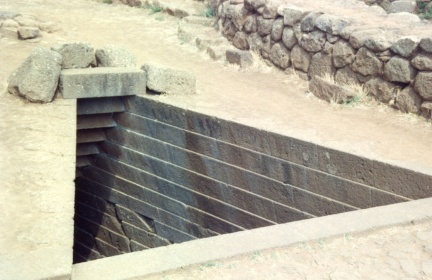The final bronze age: the sacrum sinks or sink temples
It cannot be considered concluded a speech on the astronomical bearing of the Sardinian prehistoric constructions, without taking under investigation the bearing of the sacrum sinks, of which they are known about 35 examples up to the present. In particular, in the event of the sacrum sink of Santa Cristina at Paulilatino/OR (datable approximately on 1000 b.C.), it has been assessed its opening allows the glare of the moon to its maximum declination, that happens only every 18,6 years (so called lunar gold number).

Paulilatino (OR) - Santa Cristina Sacrum Sink
The access staircase allows instead the glare of the sun at the autumnal and spring equinoxes. Fontana Coperta at Ballao and Su Puzzu at Orroli, others two sacrum sinks also have the characteristic of the glare of the moon at the maximum declination, but their staircase of access allows the glare of the sun at the summer solstice; circumstance, this last one, found also for Santa Vittoria Sink at Serri.
Also such astronomical correspondences seem connect you to the cult of the fecundation. However the sink temples are nothing but subterranean nuraghi, with one small opening up and one access staircase; the presence of the water - the land amniotic fluid - renders their assimilation with the uterus of the mother earth, still more convincing than that one of the nuragic towers. And then, why a bearing towards the lunar beams, in direction of a commonly thought feminine star too?
Perhaps, already then, the prehistoric man had become account that the union of the two elements, the male and the feminine one, was necessary but not sufficient condition for the fecundation happening. And the lunar star, whose cycle was therefore similar to the feminine menstrual cycle, seemed to particularly predispose to the every fertility for the feminine living sex. Perhaps in the sink temples they came periodically (every 18 years and means!) celebrated some rituals connected to the fertility of the Goddess land mother, particularly exalted for the intercession of the celestial Goddess mother Moon.
Bibliography
Neolithic:
Contu, Ercole, L’altare preistorico di Monte d’Accoddi, Sassari 2000.
Proverbio, Edoardo e Calledda, Pino, Orientation of pre-nuragic in northeastern Sardinia, SEAC II Annual Meeting, Sibiu (Rumania) 1995.
Copper Age:
Caocci, Alberto, La Sardegna, Milan 1981.
Lilliu, Giovanni, La civiltà dei Sardi dal neolitico all’età dei nuraghi, Turin 1967
Castaldi, Editta, Un cromlech calendariale del nuorese, 3° Convegno internazionale di archeologia e astronomia, Rome 2000.
Calledda, Pino e Murru, Giorgio, “Monumenti d’interesse astronomico nel territorio di Laconi (NU)”, in Rivista italiana di archeoastronomia, Rome 2004.
Proverbio, Edoardo e Calledda, Pino, “Orientamento di dolmen e di tombe preistoriche nella Corsica centro-meridionale”, in Rivista italiana di archeoastronomia, Rome 2004.
Astronomic bearing of Nuraghi and Giants Tombs:
Lilliu, Giovanni, La civiltà nuragica, Sassari 1982.
Maxia, Carlo e Fadda, Lello, “Nuove scoperte sulla civiltà nuragica con l’astroarcheologia”, in Frontiera I, Cagliari 1973.
Maxia, Carlo e Fadda, Lello, Il mistero dei nuraghi svelato con l’astroarcheologia, Cagliari 1984.
Proverbio, Edoardo e Calledda, Pino, “Analisi statistica degli orientamenti di tombe megalitiche in Sardegna”, in Rivista italiana di archeoastronomia, Rome 2004.
Marchisio, L., Manara, A. e Gaspani, A., ”Ricerca sulla Tomba di Giganti S’Ena e Tomes in Sardegna“, in Rivista italiana di archeoastronomia, Rome 2004.
Zedda, Mauro Peppino, I nuraghi tra archeologia e astronomia, Cagliari 2004.
Sink Temples astronomic bearing:
Proverbio, Edoardo e Calledda, Pino, “Sugli orientamenti e sulle visuali di pozzi sacri esistenti nella Sardegna centro-meridionale”, in Rivista italiana di archeoastronomia, Rome 2004.
European neolithic burial structures:
North, John, Stonehenge, 1996.
Proverbio, Edoardo, Archeoastronomia, Milan 1989.


